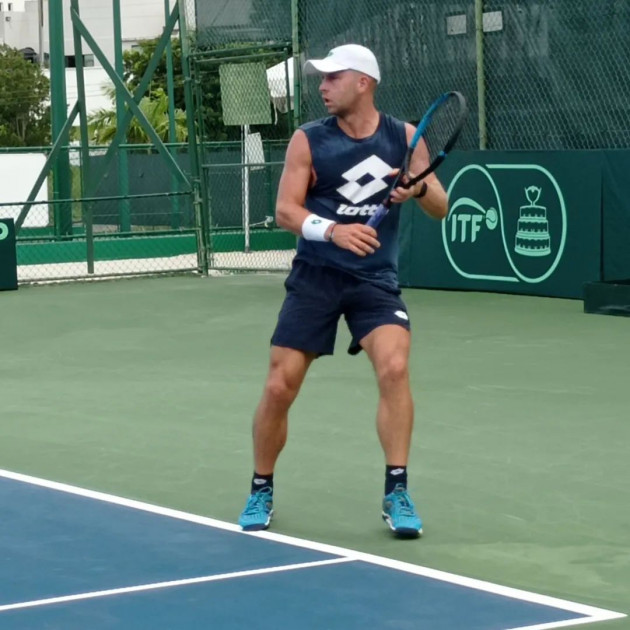LAST UPDATE | 2 Feb 2023
SPENDING THE FIRST Friday and Saturday of February 120km away from Lima in Peru as the city roils to deadly violence and political unrest – this is what tennis calls camaraderie.
The country is currently in the grip of a brutal government crackdown on popular unrest that followed the arrest of the president and the accession of vice-president Dina Boluarte, but it has been deemed an acceptable host of Ireland’s biggest Davis Cup tie for 40 years.
The Davis Cup is a very rare thing in tennis: a team event in an intensely solitary sport.
Thus it is on the the Estadio Asia’s courts outside of the Peruvian capital where Ireland’s top players will come together tomorrow to play-of against their hosts for promotion to World Group 1, the second tier of the global competition.
If Ireland can get the best of Peru in five matches across two days – four singles matches with a doubles tie in between – theirs will be the most notable achievement in Irish men’s tennis since Conor Niland and Louk Sorensen played in the main draw at the 2011 US Open.
An alluring prospect but a tall order. Peru have home advantage, meaning they have been allowed pick the court. They’ve put it on clay, a surface on which the Irish players are less experienced and on which it has been impossible to practice during the European winter. Peru also have the higher-ranked players. All five of their squad are currently higher in the world standings than Ireland’s top player, Simon Carr.
Carr is currently world number 738, whereas Peru’s top player, Juan Pablo Varillas, is ranked inside the world’s top 100 and was last seen pushing Sascha Zverev to five sets in the first round of the Australian Open.
“We haven’t been here in 40 years so we are going to leave it all out there”, Carr tells The42.
Carr – whose father Tommy played Gaelic football for Dublin before later coaching them along with Roscommon and Cavan – left school in 2015 after his Junior Cert to join the professional ranks, initially combining the senior tour with the junior circuit. “The men’s game is a totally different story to the juniors”, he explains. “The men’s tour is more cut-throat, and you’re out there on your own.”
Hence the Davis Cup oasis. Carr is this week part of a team with fellow players Osgar Ó hOisín, Michael Agwi, Jack Molloy, and Thomas Brennan, which is buttressed by support staff from Tennis Ireland. Such company is a rarity on every other week of the year.
“The loneliness on the court is the easiest part: it’s all on you and you can only blame yourself for messing up. The loneliness off the court is the problem, especially when you are travelling by yourself. There is a lot of downtime, a lot of time in hotels and airports alone. There is a lot of time to think and your head can be your own worst enemy if it’s allowed to run riot.”
It’s a world with too much room for thought. On the court players are kept between neat and tight tramlines, whereas away from it they work in a world lacking any kind of circumscription. As a tennis player, you are welcome to sign up to any tournament in the world once your ranking is high enough to permit you entry, but nobody is going to ask about you if you don’t turn up. And there are no professional contracts, so you can quit anytime you like.
A few years ago Carr flew to Mozambique for back-to-back tournaments across a fortnight, targeting a deep run across both weeks to boost his ranking. By day two he was out of the first tournament, beaten 7-6 in the third and deciding set. That night he sat eating dinner alone in Mozambique, on what was his 19th birthday.
“I was thinking about jumping on the next flight home. There are those weeks: ‘What am I doing here?’ There are a few places which will take you into that mindset.”
The most important fact of that story is that Carr didn’t quit. He hung around and made the semi-finals the following week.
“There are times, I think, being from an inferior tennis country, it may creep in that you don’t belong here”, says Carr. “It’s something you have to work on. Being Irish, you feel you don’t belong as you’re the only one out there. You need to keep convincing yourself that you are good enough and that it is possible.
“What keeps people going is the belief that some day is that it will be worth it. If you don’t believe it is possible, there are much easier things to do. There are more comfortable lives to live.”
Carr’s belief is that he can one day break the world’s top 50. His current lowly ranking is partly a consequence of injuries, as he hasn’t played since last November having pulled a hamstring, while he missed eight months across 2021 and 2022 with a fractured back. And rankings-wise, the tennis players standing still are falling behind at a rapid rate.
“That is one of the tougher parts”, admits Carr. “Especially seeing guys you rate yourself as better than climbing the rankings. Yeah, it’s not fun at all.
“But if your level is there and you know you are good enough to beat players who are quite a lot higher in the rankings, there is the possibility to shoot right up the rankings. Things can change in a week or two in tennis. It can change very fast and you have to keep that faith that could be around the corner for you.”
But more important than faith is belief. Carr’s comes from his daily work. He is based in Spain now, where he is coached by Louk Sorensen.
“Louk was 175 in the world, probably would have got higher without injuries. I can trust that he knows. If he says that my level is good enough, I can trust him. I trust that he has a great knowledge of the sport and that he will tell me if my level isn’t good enough. And that is important, as there are a lot of people in the tennis industry who will tell you stuff you want to hear but not the stuff you need to hear.”
Carr does have time on his side. He played his first professional event in 2015 but is still just 23, admitting now that he joined the senior ranks too early.
“I will be totally honest, I feel I probably did turn pro a little too early. You see a lot of guys coming out of college, especially from America, and doing quite well. It probably would have helped me to be a little fresher later on in my career. I feel I have been doing this for quite a while now, which is totally fine, I have learned so much from doing it.
“There are times I feel I am really old and have been doing this for a very long time, but there are times I have to remind myself that I am only 23 and may not reach my peak until 28 or 29.
“When you start out you’re so fresh that you are a little bit naive to it and to how difficult it is. Obviously I wouldn’t change it right now. I am happy doing what I am doing and enjoying it, and my goals keep me going every day.”



